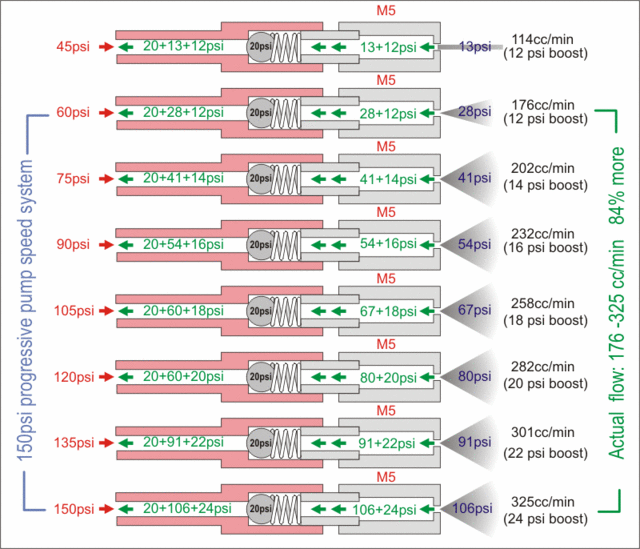Almost all progressive systems use a checkvalve between the pump output and nozzle for the reasons listed below:
Positive effects (well documented):
1. Retain some pressure in the line to compensate the next injection event. A 20psi loaded checkvalve will keep 20 psi of pressure in the line after injection.
2. Stop water being siphoned into the engine if the water jet is installed in the vacuum side of the manifold.
3. Prevent emptying the entire tank into the inlet tract if the tank location is higher than the jet (gravity fed) or the car is parked on an incline.
4. Stop some dribble after an injection event. Even when the power of the pump is switch off, the inertia of the rotating mass keeps the pump running for a second or so.
Negative effects (less well documented):
5. The presence of a checkvalve has a very significant impact of the dynamic range of a 150psi progressive pump speed system. A 20 psi checkvalve inline will instantly drop the 150 PPS system down to a 130psi span.
6. A normal nozzle requires ~30psi for produce a decent atomised spray. An inline 20psi checkvalve means the pump has to produce 50psi to produce a decent spray.
7. Let say the PPS system?s starting point is at 12psi boost, the system will now require 62psi to produce a decent spray. Some vendor will tell you a check valve will not impede flow once it is opened, true. But it will tax the pressure heavily where the PPS system relies heavily upon.
8. When the PPS system arrives at 24psi boost (end point) manifold pressure, the dynamic pressure is now further taxed. Before not too long later the dynamic range of a PPS system is now from 62psi to 126psi ? translate it to flow: 176cc/min to 326cc/min, a mere 84% percent increase.
9. I have taken some data from a reputable PPS system manufacturer, a 150-psi 60W Shurflo flow pump has the follow characteristics:
M2 nozzle with 1/8 ID hose 180psi
M3 nozzle with 1/8 ID hose 160psi
M5 nozzle with 1/8 ID hose 135psi
M14 nozzle with 1/8 ID hose 105psi
From the figures above, the pump is only capable of sustaining 135psi system pressure on a M5 nozzle. Despite claiming the pump is capable of flowing one 3-4 litre per minute, conveniently missing the pressure parameter. The above PPS system maker is the only one that published these figures in public ? thumbs up for them.
Summary:
Some PPS system makers are now offering an inline solenoid upgrade so that the dynamic range is improved by a good margin. Not sure why they didn?t include it in the kit at the beginning. Many PPS systems run their pumps up to 200-300psi - something I have questioned Shurflo, they said NO, NO and NO - no "ifs" or "buts". They are looking into a higher pressure pump but not yet done and will not be released until they are comfortable with it. I have a meeting with the Shurflo's director of engineering at our works two months ago during his UK visit - he confirmed the imaginary 200psi+ pump (8000 series).
Here is an illustration of the above in graphical form:
